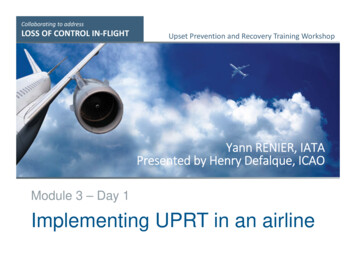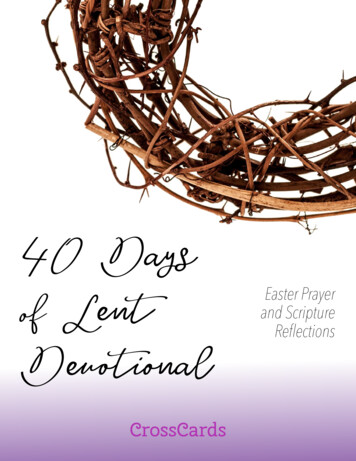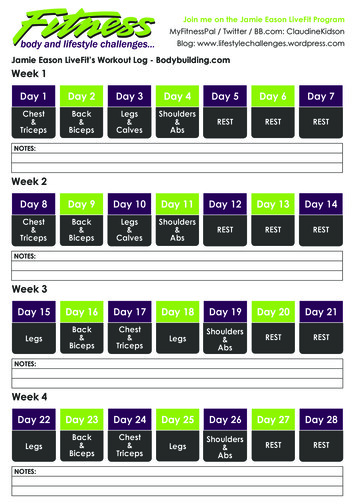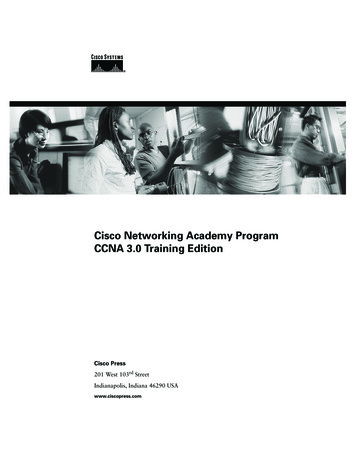
Transcription
Collaborating to addressLOSS OF CONTROL IN‐FLIGHTUpset Prevention and Recovery Training WorkshopYann RENIER, IATAPresented by Henry Defalque, ICAOModule 3 – Day 1Implementing UPRT in an airline
Collaborating to addressLOSS OF CONTROL IN‐FLIGHTUpset Prevention and Recovery Training WorkshopFlight Plan Safety Data Regulatory matters Training content Instructor qualification FSTD requirements Evaluation19 Dec 16UPRT Implementation2
Collaborating to addressLOSS OF CONTROL IN‐FLIGHTUpset Prevention and Recovery Training WorkshopSafety data: big picture19 Dec 163
Collaborating to addressLOSS OF CONTROL IN‐FLIGHTUpset Prevention and Recovery Training WorkshopAccident per million sectors per region of operator APR 201619 Dec 16UPRT Implementation4
Collaborating to addressLOSS OF CONTROL IN‐FLIGHTUpset Prevention and Recovery Training WorkshopGlobal Accidents (2011‐2014)19 Dec 16UPRT Implementation5
Collaborating to addressLOSS OF CONTROL IN‐FLIGHTUpset Prevention and Recovery Training WorkshopGlobal Fatal Accidents (2011‐2014)19 Dec 16UPRT Implementation6
Collaborating to addressLOSS OF CONTROL IN‐FLIGHTUpset Prevention and Recovery Training WorkshopAccident count19 Dec 16UPRT Implementation7
Collaborating to addressLOSS OF CONTROL IN‐FLIGHTUpset Prevention and Recovery Training WorkshopLOC‐I Accidents by Region (2011‐2015)19 Dec 168
Collaborating to addressLOSS OF CONTROL IN‐FLIGHTUpset Prevention and Recovery Training WorkshopLOC‐I Accidents by Region (2011‐2015)19 Dec 16UPRT Implementation9
Collaborating to addressLOSS OF CONTROL IN‐FLIGHTUpset Prevention and Recovery Training WorkshopLOC‐I Accidents by Phase (2011‐2015)19 Dec 1610
Collaborating to addressLOSS OF CONTROL IN‐FLIGHTUpset Prevention and Recovery Training WorkshopLOC‐I Accidents by Propulsion Type19 Dec 1611
Collaborating to addressLOSS OF CONTROL IN‐FLIGHTUpset Prevention and Recovery Training WorkshopEnvironmental & Airline Threats19 Dec 16UPRT Implementation12
Collaborating to addressLOSS OF CONTROL IN‐FLIGHTUpset Prevention and Recovery Training WorkshopFlight Crew Errors19 Dec 16UPRT Implementation13
Collaborating to addressLOSS OF CONTROL IN‐FLIGHTUpset Prevention and Recovery Training loss‐of‐control‐inflight.aspx19 Dec 16UPRT Implementation14
Collaborating to addressLOSS OF CONTROL IN‐FLIGHTUpset Prevention and Recovery Training WorkshopAvailable studies & reports on IATA website SAFETY REPORT 2015 Issued April 2016 Loss of Control In‐Flight Accident AnalysisReport Environmental Factors Affecting Loss of ControlIn‐Flight: Best Practice for Threat Recognition& Management Loss of Control In‐flight (LOC‐I) Prevention:Beyond the Control of Pilots19 Dec 16UPRT Implementation15
Collaborating to addressLOSS OF CONTROL IN‐FLIGHTUpset Prevention and Recovery Training WorkshopFlight Plan Safety Data Regulatory matters Training content Instructor qualification FSTD requirements Evaluation19 Dec 16UPRT Implementation16
Collaborating to addressLOSS OF CONTROL IN‐FLIGHTUpset Prevention and Recovery Training WorkshopReferences & regulatory frame work 2008/2017 Airplane Upset Recovery Training Aid (AURTA) Revision 2/3 2010 FAA SAFO 10012 (Recovery from stall does not mandate a predetermined value foraltitude loss) 2012 FAA AC No: 120‐109 Stall and Stick Pusher Training 2013 FAA SAFO 13002 (encourage manual flying) 2013 EASA SIB No.: 2013‐02 Stall and Stick Pusher training 2013 EASA SIB No.: 2013‐05 Manual Flight Training and Operations 2013 TCAA AC 700‐031 2013 FAA NOTICE N 8900.241 2013 ICATEE Research and Technology Report (FSTD) 2014 ICAO Annex 1 – Amdt.172; Annex 6 – Amdt.38; PANS‐TRG – Amdt. 3; Doc 10011 2015 FAA AC No: 120‐111 2015 EASA SIB No.: 2015‐07 (low speed high altitude) 2015 EASA ED Decision 2015/012/R Amendment to Acceptable Means of Complianceand Guidance Material to Part‐Definitions and Part‐ORO of Regulation (EU) No 965/201219 Dec 16UPRT Implementation17
Collaborating to addressLOSS OF CONTROL IN‐FLIGHTUpset Prevention and Recovery Training WorkshopReferences & regulatory frame work 2008/2017 Airplane Upset Recovery Training Aid (AURTA) Revision 2/3 2010 FAA SAFO 10012 (Recovery from stall does not mandate a predetermined value foraltitude loss) 2012 FAA AC No: 120‐109 Stall and Stick Pusher Training 2013 FAA SAFO 13002 (encourage manual flying) 2013 EASA SIB No.: 2013‐02 Stall and Stick Pusher training 2013 EASA SIB No.: 2013‐05 Manual Flight Training and Operations 2013 TCAA AC 700‐031 2013 FAA NOTICE N 8900.241 2013 ICATEE Research and Technology Report (FSTD) 2014 ICAO Annex 1 – Amdt.172 Annex 6 – Amdt.38 PANS‐TRG – Amdt. 3 Doc 10011 2015 FAA AC No: 120‐111 2015 EASA SIB No.: 2015‐07 (low speed high altitude) 2015 EASA ED Decision 2015/012/R Amendment to Acceptable Means of Complianceand Guidance Material to Part‐Definitions and Part‐ORO of Regulation (EU) No 965/201219 Dec 16UPRT Implementation18
Collaborating to addressLOSS OF CONTROL IN‐FLIGHTUpset Prevention and Recovery Training WorkshopRegulatory FAA:All part 121 Carriers / until 12 March 2019Initial, transition, upgrade, recurrent(FAA notice N 8900.241 of 11/4/13) EASA:EASA ED 2015/012/R (Air Operations)CAT Operators / since 04 May 2016Conversion course, recurrentLicensing (Aircrew expected 08 April 2018)19 Dec 16UPRT Implementation19
Collaborating to addressLOSS OF CONTROL IN‐FLIGHTUpset Prevention and Recovery Training WorkshopRegulatory, FAA example19 Dec 16UPRT Implementation20
Collaborating to addressLOSS OF CONTROL IN‐FLIGHTUpset Prevention and Recovery Training WorkshopFlight Plan Safety Data Regulatory matters Training content Instructor qualification FSTD requirements Evaluation19 Dec 16UPRT Implementation21
Collaborating to addressLOSS OF CONTROL IN‐FLIGHTUpset Prevention and Recovery Training WorkshopInitial training19 Dec 16ref IATA guideUPRT Implementation22
Collaborating to addressLOSS OF CONTROL IN‐FLIGHTUpset Prevention and Recovery Training WorkshopConversion & Recurrent training ref IATA guide19 Dec 16UPRT Implementation23
Collaborating to addressLOSS OF CONTROL IN‐FLIGHTUpset Prevention and Recovery Training WorkshopICAO Doc 10011A.B.C.D.E.F.G.H.I.J.K.AerodynamicsCauses and contributing factors of upsetsSafety review of accidents and incidents relating to upsetsG‐awarenessEnergy managementFlight path management (manual handling skills included)Recognition (importance of monitoring)Upset prevention and recovery techniquesSystem malfunction (fbw)Specialized training elementsHuman Factors (importance of TEM)19 Dec 16UPRT Implementation24
Collaborating to addressLOSS OF CONTROL IN‐FLIGHTUpset Prevention and Recovery Training WorkshopK. Human Factors importance of TEM19 Dec 16UPRT Implementation25
Collaborating to addressLOSS OF CONTROL IN‐FLIGHTUpset Prevention and Recovery Training WorkshopK. Human Factors importance of TEM19 Dec 16UPRT Implementation26
Collaborating to addressLOSS OF CONTROL IN‐FLIGHTUpset Prevention and Recovery Training WorkshopCascading effect19 Dec 16UPRT Implementation27
Collaborating to addressLOSS OF CONTROL IN‐FLIGHTUpset Prevention and Recovery Training WorkshopG. Recognition: importance of monitoring19 Dec 16UPRT Implementation28
Collaborating to addressLOSS OF CONTROL IN‐FLIGHTUpset Prevention and Recovery Training WorkshopMonitoring & Competencies19 Dec 16UPRT Implementation29
Collaborating to addressLOSS OF CONTROL IN‐FLIGHTUpset Prevention and Recovery Training Workshophttps://m.youtube.com/watch?v QVaQYhd Qy019 Dec 16UPRT Implementation30
Collaborating to addressLOSS OF CONTROL IN‐FLIGHTUpset Prevention and Recovery Training WorkshopICAO Doc 10011A.B.C.D.E.F.G.H.I.J.K.AerodynamicsCauses and contributing factors of upsetsSafety review of accidents and incidents relating to upsetsG‐awarenessEnergy managementFlight path management (manual handling skills included)Recognition (importance of monitoring)Upset prevention and recovery techniquesSystem malfunction (fbw)Specialized training elementsHuman Factors (importance of TEM)19 Dec 16UPRT Implementation31
Collaborating to addressLOSS OF CONTROL IN‐FLIGHTUpset Prevention and Recovery Training WorkshopICAO Doc 1001119 Dec 16UPRT Implementation32
Collaborating to addressLOSS OF CONTROL IN‐FLIGHTUpset Prevention and Recovery Training WorkshopAcademics & Practical application19 Dec 16UPRT Implementation33
Collaborating to addressLOSS OF CONTROL IN‐FLIGHTUpset Prevention and Recovery Training WorkshopAcademics & Practical applicationI Max Max Bank angle19 Dec 16UPRT Implementation34
Collaborating to addressLOSS OF CONTROL IN‐FLIGHTUpset Prevention and Recovery Training WorkshopAcademics & Practical application19 Dec 16UPRT Implementation35
Collaborating to addressLOSS OF CONTROL IN‐FLIGHTUpset Prevention and Recovery Training WorkshopAcademics & Practical application19 Dec 16UPRT Implementation36
Collaborating to addressLOSS OF CONTROL IN‐FLIGHTUpset Prevention and Recovery Training WorkshopAcademics & Practical application19 Dec 16UPRT Implementation37
Collaborating to addressLOSS OF CONTROL IN‐FLIGHTUpset Prevention and Recovery Training WorkshopAcademics & Practical application19 Dec 16UPRT Implementation38
Collaborating to addressLOSS OF CONTROL IN‐FLIGHTUpset Prevention and Recovery Training WorkshopAcademics & Practical application :Stall speed19 Dec 16UPRT Implementation39
Collaborating to addressLOSS OF CONTROL IN‐FLIGHTUpset Prevention and Recovery Training WorkshopICAO Doc 10011A.B.C.D.E.F.G.H.I.J.K.AerodynamicsCauses and contributing factors of upsetsSafety review of accidents and incidents relating to upsetsG‐awarenessEnergy managementFlight path management (manual handling skills included)Recognition (importance of monitoring)Upset prevention and recovery techniquesSystem malfunction (fbw)Specialized training elementsHuman Factors (importance of TEM)19 Dec 16UPRT Implementation40
Collaborating to addressLOSS OF CONTROL IN‐FLIGHTUpset Prevention and Recovery Training WorkshopC. Safety review of accidents and incidents relating to upset19 Dec 16UPRT Implementation41
Collaborating to addressLOSS OF CONTROL IN‐FLIGHTUpset Prevention and Recovery Training WorkshopC. Safety review of accidents and incidents relating to upset19 Dec 16UPRT Implementation42
Collaborating to addressLOSS OF CONTROL IN‐FLIGHTUpset Prevention and Recovery Training WorkshopICAO Doc 10011A.B.C.D.E.F.G.H.I.J.K.AerodynamicsCauses and contributing factors of upsetsSafety review of accidents and incidents relating to upsetsG‐awarenessEnergy managementFlight path management (manual handling skills included)Recognition (importance of monitoring)Upset prevention and recovery techniquesSystem malfunction (fbw)Specialized training elementsHuman Factors (importance of TEM)19 Dec 16UPRT Implementation43
Collaborating to addressLOSS OF CONTROL IN‐FLIGHTUpset Prevention and Recovery Training WorkshopIATA recommends to combine UPRT with manual flying skillstraining Continuous use of auto flight systems could lead to degradation ofthe pilot‘s manual handling skills and ability to recover the aircraftfrom an upset Manual handling errors have been increasing. Operators andauthorities have recognized that operators need to enhance themanual flying skills of flight crews. This includes new guidance by regulators, OEMs, and the review ofthe operator‘s policy to promote manual flying and manualthrottle/thrust operation where appropriate in line operations, andthe respective adaptation of recurrent training programs in FSTDs.19 Dec 16UPRT Implementation44
Collaborating to addressLOSS OF CONTROL IN‐FLIGHTUpset Prevention and Recovery Training WorkshopScenario‐Based Training and Upset Prevention Training scenarios should be designed in a way thatcrews can develop the competencies to recognize andmanage threats, errors and undesired aircraft statessuccessfully and to achieve a safe outcome. The ultimate training objective of scenario‐basedtraining is to avoid or arrest a divergence from theintended flight path as early as possible and secure theintended flight path. Scenarios leading to upsets, despite correctintervention by the crew, are not recommended.19 Dec 16UPRT Implementation45
Collaborating to addressLOSS OF CONTROL IN‐FLIGHTUpset Prevention and Recovery Training WorkshopManeuver‐Based Training and Upset Recovery The instructor, not the crew, takes responsibility for thecreation of the upset condition. Training starts after theupset condition has been established. Reasons/causes for upset conditions may be taken fromcase studies but should not be the responsibility of thecrew under training. The ultimate training objective is to effectively applyrecovery actions and to return the aircraft to astabilized flight path.19 Dec 16UPRT Implementation46
Collaborating to addressLOSS OF CONTROL IN‐FLIGHTUpset Prevention and Recovery Training Workshop“OEM recommendation”19 Dec 16UPRT Implementation47
Collaborating to addressLOSS OF CONTROL IN‐FLIGHTUpset Prevention and Recovery Training Workshop“OEM recommendation”19 Dec 16UPRT Implementation48
Collaborating to addressLOSS OF CONTROL IN‐FLIGHTUpset Prevention and Recovery Training WorkshopLH Learning methodology19 Dec 16UPRT Implementation49
Collaborating to addressLOSS OF CONTROL IN‐FLIGHTUpset Prevention and Recovery Training WorkshopLH learning methodology19 Dec 16UPRT Implementation50
Collaborating to addressLOSS OF CONTROL IN‐FLIGHTUpset Prevention and Recovery Training WorkshopStall eventUnloadTypespecific19 Dec 16UPRT Implementation51
Collaborating to addressLOSS OF CONTROL IN‐FLIGHTUpset Prevention and Recovery Training WorkshopExample of training syllabi19 Dec 16UPRT Implementation52
Collaborating to addressLOSS OF CONTROL IN‐FLIGHTUpset Prevention and Recovery Training WorkshopFlight Plan Safety Data Regulatory matters Training content Instructor qualification FSTD requirements Evaluation19 Dec 16UPRT Implementation53
Collaborating to addressLOSS OF CONTROL IN‐FLIGHTUpset Prevention and Recovery Training WorkshopPERSONNEL PROVIDING FSTD UPSET PREVENTION ANDRECOVERY TRAINING (UPRT)ref GM5 ORO.FC.220&230Standardisation and training should ensure that personnel providingFSTD UPRT:(1) are able to demonstrate the correct upset recovery techniques for thespecific aeroplane type;(2) understand the importance of applying type‐specific OriginalEquipment Manufacturers (OEMs) procedures for recovery manoeuvres;(3) are able to distinguish between the applicable SOPs and the OEMsrecommendations (if available);(4) understand the capabilities and limitations of the FSTD used for UPRT;(5) are aware of the potential of negative transfer of training that mayexist when training outside the capabilities of the FSTD;19 Dec 16UPRT Implementation54
Collaborating to addressLOSS OF CONTROL IN‐FLIGHTUpset Prevention and Recovery Training WorkshopPERSONNEL PROVIDING FSTD UPSET PREVENTION ANDRECOVERY TRAINING (UPRT)ref GM5 ORO.FC.220&230Standardisation and training should ensure that personnel providingFSTD UPRT:(6) understand and are able to use the IOS of the FSTD in the context ofeffective UPRT delivery;(7) understand and are able to use the FSTD instructor tools available forproviding accurate feedback on flight crew performance;(8) understand the importance of adhering to the FSTD UPRT scenariosthat have been validated by the training programme developer; and(9) understand the missing critical human factor aspects due to thelimitations of the FSTD and convey this to the flight crew receiving thetraining.19 Dec 16UPRT Implementation55
Collaborating to addressLOSS OF CONTROL IN‐FLIGHTUpset Prevention and Recovery Training WorkshopInstructors UPRT qualification process19 Dec 16UPRT Implementation56
Collaborating to addressLOSS OF CONTROL IN‐FLIGHTUpset Prevention and Recovery Training WorkshopIATA recommends for the “core group”19 Dec 16UPRT Implementation57
Collaborating to addressLOSS OF CONTROL IN‐FLIGHTUpset Prevention and Recovery Training WorkshopCore group & On‐Aeroplane UPRT Ab initio ATO (example LH) Flight test school (example AF) Specialized ATO (example Delta Airline)19 Dec 16UPRT Implementation58
Collaborating to addressLOSS OF CONTROL IN‐FLIGHTUpset Prevention and Recovery Training WorkshopAll Instructors: initial training Academics ½ day up to 1 day Practical FFS instruction 4H00 Examples of exercises: Uncommanded FLAPS retraction during climb High pitch attitude protection and Steep Turns at FL 100 Steep Turns at high altitude STALL RECOVERY (at high altitude) Uncommanded flight controls inputs Demo low speed protections STALL RECOVERY (at low altitude)19 Dec 16UPRT Implementation59
Collaborating to addressLOSS OF CONTROL IN‐FLIGHTUpset Prevention and Recovery Training WorkshopFlight Plan Safety Data Regulatory matters Training content Instructor qualification FSTD requirements Evaluation19 Dec 16UPRT Implementation60
Collaborating to addressLOSS OF CONTROL IN‐FLIGHTUpset Prevention and Recovery Training WorkshopFSTD RequirementsSee Doc 9625, 4th edition The FFS level C and D if maintained in the VTE(Validated Training Envelope) are suitable forUPRT initial and recurrent training sessions.For the time being, EASA does not require fullstall exercises. FSTD Enhancements (Stall modelling)To be evaluated by a competent authority Recognition of FSTD motion limitations Additional IOS displays or tools19 Dec 16UPRT Implementation61
Collaborating to addressLOSS OF CONTROL IN‐FLIGHTUpset Prevention and Recovery Training WorkshopFSTD limitations19 Dec 16UPRT Implementation62
Collaborating to addressLOSS OF CONTROL IN‐FLIGHTUpset Prevention and Recovery Training WorkshopFSTD limitations19 Dec 16UPRT Implementation63
Collaborating to addressLOSS OF CONTROL IN‐FLIGHTUpset Prevention and Recovery Training WorkshopFSTD Limitations19 Dec 16UPRT Implementation64
Collaborating to addressLOSS OF CONTROL IN‐FLIGHTUpset Prevention and Recovery Training WorkshopFlight Plan Safety Data Training content Instructor qualification Training delivery FSTD requirements Evaluation19 Dec 16UPRT Implementation65
Collaborating to addressLOSS OF CONTROL IN‐FLIGHTUpset Prevention and Recovery Training WorkshopEvaluation of training course effectiveness Assessment of exercises Pilot proficiency assessment Pilots’ feedback Instructors’ Observations Line Check/observation FDM (FOQA) improvements19 Dec 16UPRT ImplementationNot discussed here66
Collaborating to addressLOSS OF CONTROL IN‐FLIGHTUpset Prevention and Recovery Training WorkshopExercise / Pilot Assessment19 Dec 16UPRT Implementation67
Collaborating to addressLOSS OF CONTROL IN‐FLIGHTUpset Prevention and Recovery Training WorkshopPilot Proficiency: Competencies(Doc 9995 – Manual of Evidence‐Based Training) Aircraft Flight PathManagement, manualcontrol Aircraft Flight PathManagement,automation Application ofProceduresTechnical Communication Situation Awareness Workload Management Leadership andTeamwork Problem Solving andDecision MakingHuman Performance
Collaborating to addressLOSS OF CONTROL IN‐FLIGHT19 Dec 16UPRT ImplementationUpset Prevention and Recovery Training Workshop69
Collaborating to addressLOSS OF CONTROL IN‐FLIGHTUpset Prevention and Recovery Training WorkshopPilot Proficiency: competencies 19 Dec 16UPRT ImplementationMANAUTOPROCOMSAWORLEADEC70
Collaborating to addressLOSS OF CONTROL IN‐FLIGHTUpset Prevention and Recovery Training WorkshopPilot Proficiency: Core competencies Aircraft Flight PathManagement, manualcontrol Aircraft Flight PathManagement,automation Application ofProcedures19 Dec 16 Communication Situation Awareness Workload Management Leadership andTeamwork Problem Solving andDecision Mak
Available studies & reports on IATA website SAFETY REPORT 2015 Issued April 2016 Loss of Control In‐Flight Accident Analysis Report . 2013 FAA SAFO 13002 (encourage manual flying) 2013 EASA SIB No.: 2013‐02 Stall and Stick Pusher trai

![Welcome [dashdiet.me]](/img/17/30-day-weight-loss-journal.jpg)









